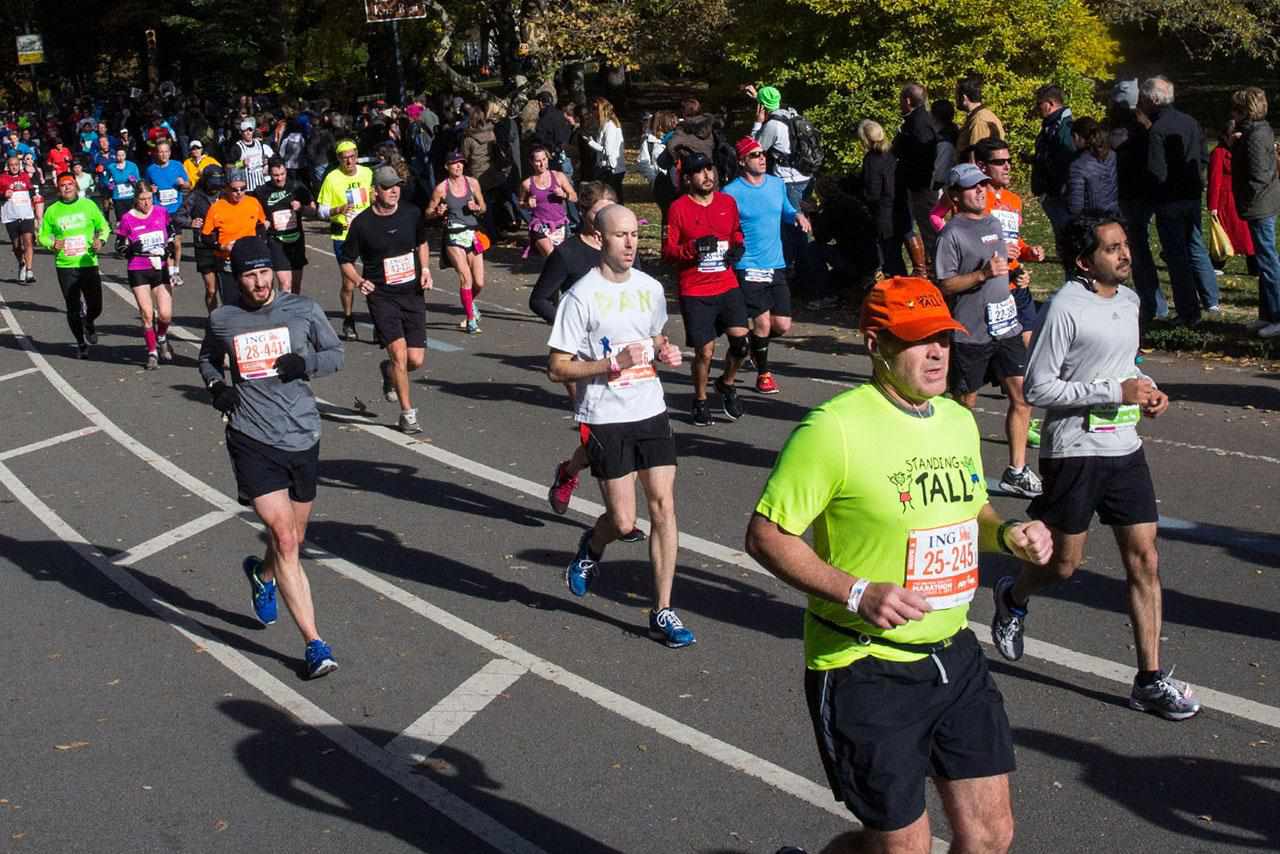

Featured
How To Run Walk A Half Marathon
Modified: January 22, 2024
Learn how to train for and successfully complete a half marathon with our featured guide. Whether you prefer running or walking, we've got you covered!
Introduction
Running a half marathon is a thrilling and rewarding experience. Whether you are a seasoned runner or a beginner looking to challenge yourself, completing a half marathon can be a tremendous accomplishment. However, it requires proper training, dedication, and preparation. In this article, we will guide you through the steps necessary to run or walk a half marathon successfully.
Preparing for a half marathon involves more than just lacing up your running shoes and hitting the pavement. It requires setting a training plan, ensuring you have the right gear and attire, incorporating warm-up and stretching exercises into your routine, focusing on proper nutrition and hydration, implementing effective running techniques and pacing strategies, building endurance, cross-training, allowing for adequate rest and recovery, and mentally preparing yourself for the challenges ahead.
By following these steps and incorporating them into your training regimen, you’ll increase your chances of crossing the finish line with a sense of accomplishment and pride. So, let’s dive into each of these aspects in detail to help you prepare for a remarkable half marathon experience!
Setting a Training Plan
Before embarking on your half marathon journey, it’s crucial to establish a well-structured training plan. This plan will outline your weekly mileage, long runs, and rest days, gradually building up your endurance while minimizing the risk of injury.
Start by assessing your current fitness level. Consider how often you currently run and the distance you can comfortably cover. This will help you determine an appropriate starting point for your training plan.
Next, set a realistic goal for yourself. Do you want to complete the half marathon in a specific time, or is finishing the race your primary objective? Having a clear goal will help shape your training plan and keep you motivated throughout the process.
Divide your training plan into phases, typically lasting for 10-12 weeks. During the initial phase, focus on gradually increasing your mileage and building a strong foundation. Include a mix of easy runs, tempo runs, and hill training to develop your speed and strength.
As you progress, incorporate longer runs into your schedule, gradually increasing the distance week by week. Aim to complete at least one long run per week, gradually building up to the half marathon distance a few weeks before race day. This will not only prepare your body physically but also mentally for the challenges ahead.
Remember to include rest days in your training plan. Rest is just as important as running when it comes to improving performance and preventing injury. Listen to your body and allow for adequate recovery time between runs. Additionally, consider incorporating cross-training activities such as cycling or swimming to diversify your workouts and give your running muscles a break.
Finally, be flexible with your training plan. Life happens, and it’s essential to be adaptable. If you miss a scheduled run or need to adjust your training days, don’t stress. Make adjustments as needed while still maintaining consistency in your training.
Setting a training plan is a critical step in your half marathon journey. It provides structure, keeps you accountable, and ensures that you are progressing towards your goal. So, take the time to plan your training schedule and set yourself up for success.
Proper Gear and Attire
When it comes to running a half marathon, having the right gear and attire is essential to ensure a comfortable and enjoyable experience. The right equipment can help prevent injuries, enhance performance, and make your training and race day much smoother.
First and foremost, invest in a good pair of running shoes. Visit a specialty running store and get properly fitted by a professional. They will analyze your gait and recommend shoes that provide the right support and cushioning for your feet. Remember to replace your running shoes every few hundred miles to maintain their effectiveness.
In addition to shoes, wearing moisture-wicking clothing is crucial. Avoid cotton material as it tends to retain moisture, leaving you feeling sweaty and uncomfortable throughout your run. Opt for technical fabrics that wick away sweat and keep you dry. Look for clothing that provides breathability and freedom of movement.
Consider the weather conditions when choosing your attire. For hot and sunny days, wear lightweight, light-colored clothing that reflects the sun’s rays. On colder days, layer your clothing to protect yourself from the elements and remove layers as needed during your run. Don’t forget to wear a hat or visor and apply sunscreen to protect yourself from sunburn.
Socks are often overlooked, but they play a vital role in preventing blisters and providing comfort during your run. Invest in moisture-wicking socks with cushioning or padding in the right areas. Experiment with different brands and styles to find the ones that work best for you.
Another essential gear to consider is a properly fitting sports bra for women. Choose a bra that provides adequate support during your runs to prevent discomfort and potential long-term damage.
For longer distances like a half marathon, it’s also beneficial to carry a small water bottle or hydration pack to stay hydrated throughout your run. Consider using a running belt or waist pack to carry essentials like energy gels, keys, and your phone.
Lastly, don’t forget about accessories like a GPS watch or a smartphone app to track your distance, pace, and progress. Having this information can help you stay on track during your training and ensure you’re pacing yourself effectively on race day.
Investing in proper gear and attire is an investment in your running experience. It can significantly impact your comfort, performance, and overall enjoyment of the half marathon. So, take the time to research and choose the right gear that suits your needs and preferences.
Warm-Up and Stretching
Before you embark on your half marathon, it’s essential to incorporate a proper warm-up and stretching routine into your training regimen. Warm-up exercises prepare your body for the physical demands of running, increase blood flow to your muscles, and help prevent injuries.
A warm-up should consist of dynamic exercises that target major muscle groups and joints. Start with a brisk walk or an easy jog for 5 to 10 minutes to elevate your heart rate gradually. This will warm up your cardiovascular system and increase blood flow to your muscles.
After the initial warm-up, move on to dynamic stretching exercises. These movements involve actively moving your muscles and joints through a full range of motion. Examples of dynamic stretches include walking lunges, leg swings, high knees, and arm circles. Perform each stretch for 10 to 12 repetitions on each side.
The purpose of dynamic stretching is to improve your mobility, activate your muscles, and prepare them for the specific movements involved in running. It’s important to avoid static stretching (holding a stretch for a prolonged period) before running because it can actually decrease muscle power and performance.
Once you have completed your warm-up and dynamic stretching routine, you are ready to start your run. But don’t forget about post-run stretching! After your run, when your muscles are warm, take a few minutes to stretch your major muscle groups. Focus on your calves, hamstrings, quadriceps, hip flexors, and glutes. Hold each stretch for 20 to 30 seconds and remember to breathe deeply and relax into the stretch.
Incorporating warm-up exercises and dynamic stretching into your training routine will not only prepare your body for the physical demands of running but also help prevent injuries such as muscle strains and sprains. It’s a crucial step in your half marathon journey that should not be overlooked.
Remember, each warm-up routine and stretching session should be tailored to your individual needs and preferences. Experiment with different exercises and stretches to find the ones that work best for your body. Consult with a fitness professional if you need guidance or have specific concerns.
Nutrition and Hydration
Proper nutrition and hydration are key factors in successfully completing a half marathon. Fueling your body with the right nutrients before, during, and after your runs will optimize your performance, aid in muscle recovery, and prevent fatigue and dehydration.
Prior to your runs, it’s important to focus on consuming a balanced diet that includes carbohydrates, proteins, and healthy fats. Carbohydrates provide the primary source of energy for your muscles, so incorporate foods like whole grains, fruits, and vegetables into your meals. Protein is essential for muscle repair and recovery, so include lean sources such as chicken, fish, tofu, and legumes. Healthy fats found in avocados, nuts, and olive oil provide long-lasting energy and support overall health.
Hydration is crucial both during your training runs and on race day. Drink plenty of water throughout the day to stay hydrated. During longer runs, consider carrying a small water bottle or wearing a hydration pack to sip on water or sports drinks as needed. It’s recommended to aim for about 4 to 8 ounces of fluid every 15 to 20 minutes during your runs.
In addition to hydration, replenishing electrolytes is important, especially during more extended runs. Electrolytes such as sodium, potassium, and magnesium are crucial to maintain the balance of fluids in your body. Sports drinks or electrolyte supplements can help replenish these nutrients during longer runs.
Practice your nutrition and hydration strategy during your training runs to determine what works best for you. Everyone’s body is different, so experiment with different foods, fluids, and timing. It’s crucial to understand how your body responds to different fuels and adjust accordingly to avoid any digestive issues or energy crashes on race day.
Before your half marathon, have a pre-race meal that consists of easily digestible carbohydrates, a moderate amount of protein, and minimal amounts of fat and fiber. Examples include a bagel with peanut butter, a bowl of oatmeal with fruits, or a banana with a protein shake.
During your half marathon, consume fuel at regular intervals to sustain energy levels. Energy gels, chews, or sports drinks can provide a quick boost of carbohydrates. Remember to take small sips of water or sports drinks to stay hydrated throughout the race.
After completing your half marathon, replenish your body with a post-race meal within 30 to 60 minutes. This meal should include carbohydrates and proteins to aid in muscle recovery. Examples include a turkey sandwich, a protein smoothie, or a bowl of pasta with grilled chicken.
Nutrition and hydration play a vital role in your half marathon journey. Properly fueling and hydrating your body will optimize your performance, aid in recovery, and ensure a successful race day. Make nutrition and hydration a priority throughout your training and on race day to reach your goals and stay healthy.
Running Techniques and Pacing Strategies
Running techniques and pacing strategies are essential components of a successful half marathon. By implementing proper form and pacing, you can optimize your energy efficiency, prevent injuries, and maintain a consistent speed throughout the race.
Firstly, focus on your running form. Maintain an upright posture with your head up, looking straight ahead. Keep your shoulders relaxed and avoid excessive arm swinging. Your arms should be bent at a 90-degree angle, swinging in sync with your leg movements. Strive for a smooth and efficient stride, landing mid-foot and rolling through to your toes.
Pay attention to your breathing as well. Find a rhythmic pattern that suits your pace and stick to it. Inhale deeply through your nose and exhale through your mouth, allowing for efficient oxygen exchange.
Pacing is crucial in a half marathon as it helps you maintain consistency and avoid burning out too quickly. Start conservatively, resisting the urge to go out too fast at the beginning. Develop a pacing strategy based on your training and goal time, aiming for negative splits (running the second half faster than the first).
Train with a GPS watch or utilize smartphone apps to track your pace during your training runs. This will help you become familiar with different paces and learn to gauge your effort levels without relying solely on technology on race day.
Practice running at your goal race pace during your training runs. This will help you establish a sense of rhythm and allow your body to adapt to maintaining a specific speed.
During the race, pay attention to your body and adjust your pace accordingly. If you start to feel fatigued, slow down slightly to conserve energy. Use the energy of the crowd and other runners to maintain motivation and push through challenging moments.
It’s also important to incorporate interval training and tempo runs into your training routine. These workouts will help you improve your speed and endurance, allowing you to maintain a faster pace for longer periods of time.
Remember, everyone’s optimal running technique and pacing strategy may vary. Experiment with different techniques and strategies during your training to find what works best for you. Consult with a running coach or experienced runners for guidance if needed.
By focusing on your running form, developing effective pacing strategies, and training with purpose, you’ll be well-equipped to tackle your half marathon with confidence and achieve your goals.
Building Endurance
Building endurance is a critical aspect of preparing for a half marathon. Endurance training allows your body to sustain a steady pace for an extended period, helping you conquer the distance and cross the finish line strong. By incorporating specific workouts into your training plan, you can gradually increase your stamina and improve your overall endurance.
One of the most effective ways to build endurance is through long runs. These runs should be done at a slower pace than your race pace but gradually increase in distance over time. Start with a comfortable distance and gradually add a mile or two each week. Push yourself, but also listen to your body and avoid overexertion or injury.
It’s important to remember that building endurance takes time. Begin your training plan with shorter runs and gradually increase the duration and distance. Consistency is key. Stick to your training schedule and aim to run at least three to four times per week, gradually increasing your mileage each week.
Interval training is another valuable tool for building endurance. It involves alternating between periods of high-intensity effort and active recovery. For example, you might run at a faster pace for one minute followed by a slower jog or walk for two minutes. This type of training helps improve your cardiovascular capacity and teaches your body to recover quickly.
Tempo runs are another effective way to build endurance. These runs involve running at a comfortably hard pace, challenging your body to sustain a faster tempo for an extended period. Start with shorter tempo runs, such as 10-15 minutes, and gradually increase the duration over time.
Endurance training is not just about running. Incorporating cross-training activities, such as cycling, swimming, or strength training, into your routine can also enhance your overall endurance and reduce the risk of overuse injuries.
During your training, keep track of your progress and celebrate the small victories along the way. Gradually increasing your mileage, completing longer runs, or completing a challenging interval workout are achievements to be proud of. Trust the process, be patient, and remember that each run is a step towards building your endurance.
Building endurance is a gradual process, and it requires consistent effort, dedication, and patience. Incorporate long runs, interval training, and tempo runs into your training plan, and don’t forget the importance of cross-training. With time and persistence, you’ll develop the endurance necessary to conquer your half marathon and achieve your goals.
Cross-Training
Cross-training is a valuable addition to any half marathon training plan. Incorporating activities other than running into your routine provides numerous benefits, including injury prevention, enhanced overall fitness, and improved running performance.
Engaging in cross-training activities allows you to work different muscle groups, reduce the risk of overuse injuries, and improve your cardiovascular fitness. It also provides mental stimulation and helps prevent burnout by adding variety to your training routine.
There are several cross-training options to consider, depending on your personal preferences and availability. Cycling is a low-impact activity that builds lower-body strength while providing a cardiovascular workout. It can be done outdoors or on a stationary bike.
Swimming is another excellent cross-training option. It is a full-body workout that builds endurance and improves lung capacity without putting stress on joints. Swimming also aids in recovery by promoting blood flow and reducing muscle soreness.
Strength training is crucial for runners as it helps improve muscular strength, power, and stability. Focus on exercises that target the major muscle groups involved in running, such as squats, lunges, deadlifts, and core exercises. Incorporate both bodyweight exercises and weighted exercises to build overall strength and stability.
Yoga and Pilates are fantastic for improving flexibility, balance, and core strength. These activities also promote relaxation and can aid in recovery. Regular stretching sessions or participation in a yoga or Pilates class can improve running form and prevent muscle imbalances.
Consider incorporating high-intensity interval training (HIIT) sessions into your cross-training routine. These workouts involve short bursts of intense activity followed by periods of rest or lower intensity. HIIT workouts are excellent for improving cardiovascular fitness, increasing speed, and boosting overall endurance.
Remember to plan your cross-training sessions strategically within your training plan. Aim for two to three cross-training sessions per week, alternating them with your running workouts. Be mindful of allowing for adequate rest and recovery time, as cross-training activities can also exert strain on your body.
Listen to your body during cross-training sessions and adapt the intensity and duration according to your fitness level and energy levels. The goal is to complement your running training, not to exhaust yourself or impede your progress. Adjust the intensity of the cross-training sessions based on your current training phase and how your body is responding.
Cross-training provides an opportunity to work on different aspects of fitness, improve overall strength and flexibility, and prevent overuse injuries. Incorporate a variety of activities that you enjoy into your training plan to keep it engaging and balanced. With consistent cross-training, you’ll become a stronger, more well-rounded athlete ready to tackle your half marathon.
Rest and Recovery
Rest and recovery are often overlooked but fundamental aspects of half marathon training. Allowing your body time to rest and recover is crucial for muscle repair, injury prevention, and overall performance. Neglecting rest can lead to overtraining, fatigue, and increased risk of injury. Here are some essential tips for incorporating rest and recovery into your training plan.
Firstly, ensure you have rest days scheduled into your training plan. Rest days are just as important as your running days, as they allow your body time to repair and rebuild. On these days, avoid any strenuous activities and focus on gentle stretching or engaging in low-impact activities such as walking or yoga.
Listen to your body and pay attention to any warning signs of overtraining. If you experience persistent fatigue, muscle soreness, or decreased performance, it may be a sign that you need additional rest. Adjust your training plan accordingly and allow yourself an extra day or two of rest to recover fully.
Incorporate active recovery days into your routine. These are lighter workout days that help promote blood flow, reduce muscle soreness, and aid in recovery. Engage in low-intensity activities like swimming, cycling, or gentle jogging to keep your body moving without putting excessive strain on your muscles.
Focus on getting adequate quality sleep. Sleep is when your body repairs and regenerates. Aim for seven to nine hours of uninterrupted sleep each night to support your training efforts. Establish a bedtime routine and create a sleep-friendly environment to optimize your sleep quality.
Pay attention to your nutrition during the recovery phase. Properly fueling your body with a balanced diet that includes carbohydrates, proteins, and healthy fats will aid in muscle repair and recovery. Include foods rich in antioxidants, such as fruits and vegetables, to promote overall health and reduce inflammation.
Utilize recovery tools to aid in your post-run recovery. Foam rollers, massage balls, compression gear, and ice baths are just a few examples of tools that can help relieve muscle soreness, reduce inflammation, and promote healing. Experiment with different recovery methods and find what works best for you.
Mental rest is also essential for recovery. Incorporate activities that help reduce stress, such as meditation, deep breathing exercises, or engaging in hobbies you enjoy. Taking time to relax and recharge mentally is just as important as physical rest.
Finally, embrace the concept of tapering as you approach race day. Tapering involves reducing the intensity and volume of your training in the weeks leading up to the half marathon. This allows your body to fully recover and prepare for the race, ensuring you are in peak condition on race day.
Rest and recovery are vital components of half marathon training. By incorporating rest days, active recovery, quality sleep, proper nutrition, and mental relaxation into your training plan, you will optimize your performance, reduce the risk of injury, and approach race day feeling refreshed and prepared.
Mental Preparation
Mental preparation plays a significant role in successfully completing a half marathon. A strong and focused mindset can help you overcome challenges, push through fatigue, and maintain motivation throughout your training and on race day. Here are some tips to help you mentally prepare for your half marathon:
Visualize success. Take the time to imagine yourself crossing the finish line, feeling strong and accomplished. Visualizing yourself achieving your goals can boost your confidence and motivation, making it easier to stay focused during training and on race day.
Set realistic expectations. While it’s essential to have goals, it’s equally important to set realistic expectations for yourself. Be aware of your current fitness level and the time and effort required to reach your desired outcome. Setting achievable goals will prevent disappointment and keep you motivated throughout the process.
Practice positive self-talk. Train your mind to focus on positive thoughts and affirmations. Replace negative thoughts with encouraging and empowering statements. Remind yourself of previous achievements and the progress you’ve made so far. Positive self-talk can help build confidence and maintain a positive mindset.
Break the race into smaller milestones. Instead of thinking about the full distance of the half marathon, break it down into smaller segments. Focus on reaching the next mile marker or aid station. This mental strategy helps prevent feeling overwhelmed, allowing you to stay focused and motivated as you progress through the race.
Develop a race strategy. Having a well-thought-out race strategy can provide structure and confidence on race day. Determine your pacing plan, hydration and fueling strategies, and how you will handle difficult moments during the race. Having a plan in place minimizes decision-making on the spot and keeps you mentally focused.
Practice mindfulness and relaxation techniques. Incorporate mindfulness exercises, deep breathing, or meditation into your training routine. These techniques can help reduce pre-race anxiety, improve focus, and promote a calm state of mind. Experiment with different relaxation techniques to find what works best for you.
Stay present. Focus on the current moment rather than dwelling on what’s behind or worrying about what lies ahead. Stay present during your training runs, being mindful of your form, breathing, and surroundings. Practice this presence of mind during training to develop the skill of staying in the moment on race day.
Find a mantra. Choose a short, powerful phrase or mantra that resonates with you. Repeat it to yourself during challenging moments in training and on race day. Whether it’s “I am strong” or “I can do this,” having a mantra can help refocus your mind and provide a sense of empowerment.
Stay flexible and embrace unpredictability. Remember that not everything will go exactly as planned, and there may be unexpected obstacles along the way. Stay adaptable and be prepared to adjust your mindset and race strategy if needed. Staying flexible will help you navigate any challenges that arise during your half marathon.
Mental preparation is key to a successful half marathon experience. By visualizing success, setting realistic expectations, practicing positive self-talk, breaking the race into smaller milestones, developing a race strategy, incorporating mindfulness, staying present, finding a mantra, and embracing unpredictability, you’ll be mentally equipped to overcome challenges and achieve your goals.
Race Day Strategies
Race day for a half marathon is an exciting and adrenaline-filled experience. Having a well-thought-out race day strategy will help you stay focused, maintain your energy levels, and maximize your performance. Here are some key strategies to consider for a successful half marathon race day:
Arrive early. Give yourself plenty of time to get to the race venue, park, and check-in. Arriving early allows you to familiarize yourself with the surroundings, use the restroom, and warm up properly without rushing.
Stick to your routine. Race day is not the time to try new gear, fueling methods, or clothing. Stick with what has worked for you during your training runs. Familiarity and consistency will help you feel more comfortable and confident on race day.
Start slow and pace yourself. It can be tempting to start too fast in the excitement of the race, but pacing is crucial for success. Begin at a comfortable pace, slightly slower than your goal race pace, and gradually increase your speed as the race progresses.
Use the water stations strategically. Take advantage of the water stations along the course, but don’t try to drink a full cup in one go. Take small sips or use the “sip and pinch” technique to prevent choking. If you’re carrying your own hydration, plan when and where to refill or replace your water bottle.
Take walk breaks if needed. Walking during a half marathon is perfectly acceptable and can actually help conserve energy and prevent burnout. If you feel the need to walk, do so during designated intervals or on uphill sections. Resume running once you catch your breath or reach a flatter terrain.
Stay mentally focused. During the race, stay present and focused on each mile or kilometer. Use the scenery, crowd support, and fellow runners to keep your motivation high. If negative thoughts creep in, replace them with positive affirmations or your chosen mantra.
Utilize cheering sections. Take advantage of the energy and support from the spectators along the course. Their cheers and encouragement can give you a mental boost and help take your mind off any physical fatigue.
Break the race into segments. Mentally divide the race into smaller achievable goals. Focus on reaching the next mile marker, water station, or landmark. Celebrate each milestone you achieve along the way, boosting your confidence and motivation.
Stay flexible and adapt. Be prepared to adjust your race day strategy if needed. If the weather conditions change, adjust your pacing. If you’re feeling stronger than expected, consider picking up the pace towards the end of the race. Staying flexible allows you to adapt to any unforeseen circumstances and make the best decisions for your race.
Finish strong. As you near the final stretch of the half marathon, dig deep and give it your all. Use any extra energy reserves you have left to push through and finish strong. This is the time to tap into your mental toughness and embrace the sense of accomplishment as you cross the finish line.
Remember, everyone’s race day strategy may vary. It’s essential to develop a strategy that works best for you based on your training, abilities, and goals. Implement these strategies, stay focused, and enjoy every moment of your half marathon race day.
Post-Race Recovery and Reflection
After crossing the finish line of your half marathon, it’s essential to prioritize proper post-race recovery to aid in muscle repair and replenishment. Additionally, taking time to reflect on your accomplishment allows you to celebrate your achievement and gain insights for future races. Here are some key post-race recovery and reflection strategies to consider:
Take a moment to celebrate. Allow yourself to bask in the glory of completing your half marathon. Reflect on the hard work, dedication, and perseverance it took to reach the finish line. Celebrate your achievement, whether it’s through sharing the experience with loved ones or treating yourself to a small reward.
Rehydrate and refuel. Replace fluids and replenish your energy stores by hydrating with water or a sports drink. Consume a post-race meal or snack that includes a balance of carbohydrates and protein to aid in muscle recovery. Foods like fruits, vegetables, lean proteins, and whole grains are ideal choices.
Engage in light activity. After a half marathon, it’s beneficial to keep moving at a gentle pace. Take a short walk or engage in low-impact activities to promote blood circulation and prevent stiffness. Avoid any high-intensity workouts or activities in the immediate aftermath of the race.
Practice gentle stretching. Perform gentle stretches or use a foam roller to ease tension in your muscles. Focus on major muscle groups like your calves, hamstrings, quadriceps, hips, and glutes. Stretching will help prevent post-race soreness and aid in muscle recovery.
Allow for adequate rest. Give your body time to recover by incorporating rest days into your post-race plan. Listen to your body and rest when needed. Adequate rest ensures full recovery, reduces the risk of injury, and sets the foundation for future training.
Reflect on your performance. Take time to reflect on your half marathon experience. Consider what went well, what challenges you faced, and what you learned from the race. Reflecting on your performance can provide valuable insights for future training and help you set new goals.
Celebrate your achievements and set new goals. Acknowledge your accomplishment and be proud of yourself. Take note of any milestones you achieved during the race, whether it be a personal record, overcoming mental barriers, or simply completing the distance. Use this experience as motivation to set new goals for future races.
Evaluate your training and identify areas for improvement. Review your training plan, nutrition, and rest and recovery strategies. Assess what worked well and what could be improved upon. Identify areas of weakness or opportunities for growth, and make adjustments accordingly for future training cycles.
Stay positive and maintain momentum. Don’t let the post-race blues hinder your progress. Stay positive and use the momentum from your half marathon to carry you forward into your next running endeavors. Reflecting on your success can help boost your confidence and keep you motivated for future races.
Post-race recovery and reflection are essential to optimize your recovery and set the stage for future achievements. By adopting these strategies, you’ll not only give your body the care it needs but also gain valuable insights to continually improve your running performance.
Conclusion
Congratulations on embarking on the journey of training for a half marathon! By following the steps outlined in this article, you’re well on your way to a successful and fulfilling race day experience.
We began by emphasizing the importance of setting a training plan that suits your current fitness level and goals. Remember to gradually increase your mileage, incorporate different types of runs, and allow for rest and recovery days. This will not only build your endurance but also reduce the risk of injury.
Proper gear and attire are crucial for a comfortable and enjoyable run. Invest in a good pair of running shoes, moisture-wicking clothing, and consider accessories like a GPS watch for tracking your progress.
Warming up, stretching, and maintaining proper running form are essential for injury prevention and performance optimization. Additionally, focus on nutrition, hydration, and fueling strategies to ensure your body has the energy it needs during training and on race day.
Building mental strength and resilience is just as important as physical preparation. Practice positive self-talk, visualize success, and develop a race day strategy to keep your mind focused and motivated.
Finally, allow for adequate post-race recovery and reflection. Celebrate your accomplishment, refuel your body, engage in light activity, and take time to reflect on your performance and set new goals.
Remember, every journey is unique, and your half marathon experience will be shaped by your dedication, perseverance, and determination. Enjoy the process, listen to your body, and embrace the lessons learned along the way.
Now, lace up your shoes, hit the pavement, and make your half marathon dreams a reality. The road awaits, and with proper training, preparation, and a strong mindset, you’ll conquer those 13.1 miles and cross the finish line with a sense of pride and accomplishment!









